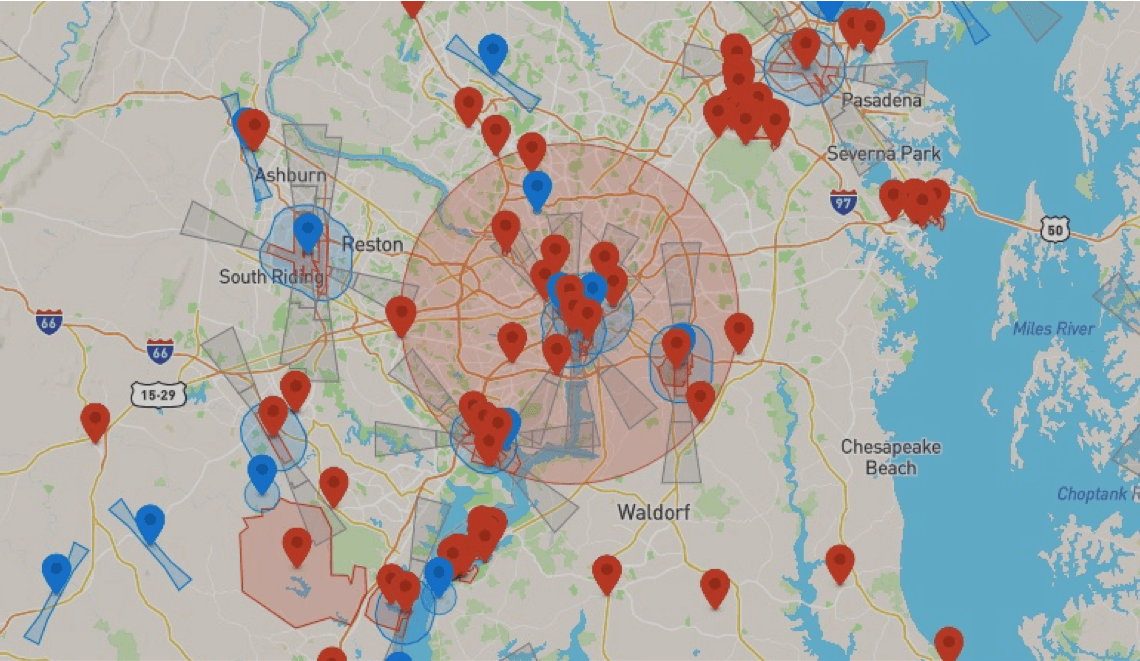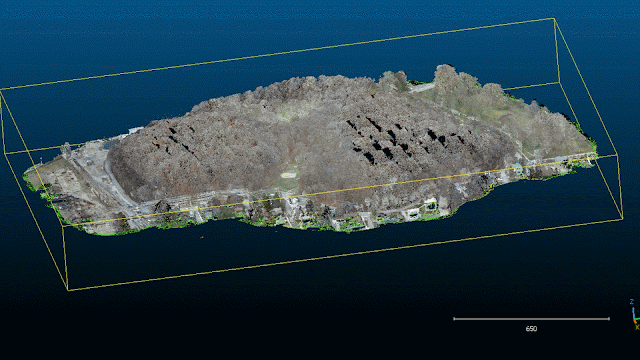Regrettably, a majority of the cost-effective enterprise unmanned aerial systems (UAS) currently available in the market are bound by a maximum flight duration of approximately 30 minutes. This inherent restriction poses a considerable hindrance to the success of missions that demand a substantial investment of energy, time, and perseverance. While the notion of the future technological advancements in wireless technology fills one with optimism, the reality remains that the GET wireless charging solution for UAS is an impressive and promising concept that warrants attention and can be found in the follwing video.
A continuously updated website highlighting my experiences of UAS, the data, and the deliverables Unmanned Aerial Vehicles (UAVs) can provide.
Sunday, April 16, 2023
Overcoming Geofencing Challenges with DJI Drones
KSBN Case Study
For a mission taking place less than half a mile from South Bend's International Airport, I had to implement numerous safety measures to ensure that the unmanned aerial system (UAS) would not interfere with any nearby manned aircraft operations. After submitting a comprehensive mission plan, risk assessment matrix, and coordinating with local entities, I obtained a waiver permitting me to fly at a ceiling of 50 feet above ground level (AGL) to inspect two bridge decks using a DJI M210 and an XT2 camera. While using the DJI UAS, the operating location appeared to be outside DJI's restricted geofence zone, as shown in Figure 1. However, upon arriving on site, the aircraft incorrectly indicated that I was in a no-fly zone.
 |
| Figure 1: False Lock at Operation Location Outside of Restricted Zone |
What did I do?
Fortunately, I had downloaded a custom unlock from DJI's website before arriving on site. Although the custom unlock feature worked, I was concerned by the discrepancy between DJI's geofence map and the real-time location. If I had relied solely on DJI's geozone map and not unlocked the aircraft, the mission would have failed, as I would have missed the 30-minute window I had to fly.
What did I Learn?
Although DJI's geofence is an essential safety tool, the aircraft's real-time location may sometimes trigger a false lock. If you are not familiar with DJI's unlocking process, you may experience a significant disruption for no valid reason. DJI claims that you can unlock your drone as long as you are connected to the internet; however, I was unable to do so with the M210 RTK V2, despite having a full internet connection and the tablet indicating that the unlock was verifying.
Conclusion
If you have a DJI aircraft and have permission to legally operate in a zero grid, make sure that you know how to unlock in case you end up in a situation like mine. Also know that in the unlocking process, your aircraft will be set at an altitude from the takeoff point, so consider that when selecting a takeoff location ahead of time.
Sunday, April 2, 2023
Adobe Lightoom Photo Merge
Overview
Adobe Lightroom is an image organization software that allows you to stitch, edit, and manipulate photos. In this post, you will learn how I use Lightroom to merge photos of large structures like bridges.
The Need for Merged Photos
Due to restrictions on altitude when capturing images with aircraft like the DJI M210, I often need to fly far away and capture oblique photos rather than nadir photos. Oblique photos can be stitched together to create a more detailed image, hence the need for merged photos.
Alternatives to Merging Photos
While photogrammetry platforms like Pix4D can be used to create an Orthomosaic, I found Adobe Lightroom to be a more straightforward and efficient alternative. Lightroom is particularly useful when dealing with projects that include water.
Why Adobe Lightroom?
I found adobe lightroom to be fairly easy to merge photos compared to Pix4D. Many projects I fly include water and as of this post, Lightroom has done well with fewer distractions in my experience.
A Case Study with the DJI Zenmuse XT2
The XT2 camera captures both visual and thermal images and is compatible with the DJI Matrice 200 and 300 series. To scan infrastructure like bridge decks, I take a series of thermal photos and visual photos. The visual photos are used to map the structure and serve as comparison photos to the thermal images.
After importing the 47 visual photos captured by the XT2 into Lightroom (see Figure 1), I select all the photos and click the Perspective Merge function (See Figure 2). The photos take about a minute to process. Refereencing Figure's 2 and 4, the Boundary Wrap function helps correct the fisheye distortion common with the XT2 camera, and any remaining lens distortion can be corrected using open-source software or Adobe Photoshop.
 |
| Figure 1: 47 Photos Loaded to Adobe Lightroom |
 |
| Figure 2: Perspective Merge Function |
 |
| Figure 3: Merge Before Applying Boundary Wrap |
 |
| Figure 4: Merge After Applying Boundary Weap |
 |
| Figure 5: Distortion Correction Settings in Adobe Photoshop |
 |
| Figure 6: Merged Imagery From Zenmuse XT2 |
Saturday, March 25, 2023
Does Entry Level LiDAR Offer Value?
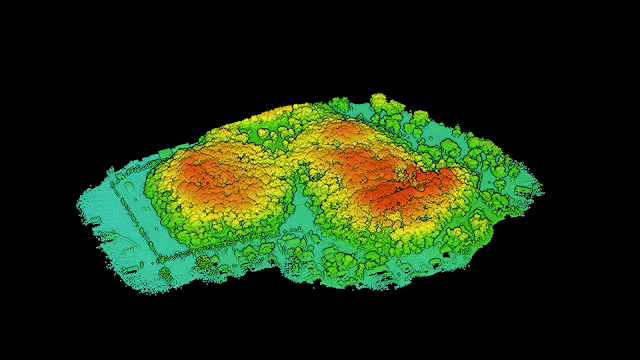 |
| Looking at LiDAR Point Cloud Collected by L1 and Generated in DJI Terra |
Overview
Last year, I had the chance to rent a DJI Matrice 300 RTK and test its L1 LiDAR sensor (Figure 1). The L1 is DJI's first commercial LiDAR system, and its affordability caught my attention. Although I'd love to operate a $100,000+ cm survey-grade accurate LiDAR system, my current resources don't allow me to afford such an expensive system. Additionally, renting a survey-grade LiDAR is significantly pricier than renting an entry-level LiDAR.
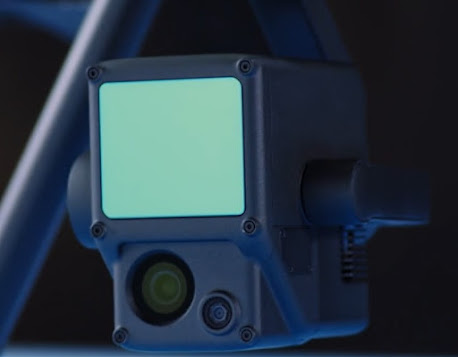 |
| Figure 1: DJI L1 |
The point clouds generated by this system were impressive, particularly in areas with dense vegetation. However, visually pleasing point clouds are useless if we can't use them! This post aims to share my experiences with the L1, helping you better understand what it takes to make entry-level LiDAR work..
What is Entry Level LiDAR?
There is no definition of entry level LiDAR but I have classified the L1 an entry level LiDAR system because in my opinion, although it is not a survey grade LiDAR system, many people will purchase it as their first LiDAR UAS due to it’s simplicity, availability and affordability. Is it possible to obtain survey grade data using the L1? Since I am not a licensed surveyor, I shouldn’t answer that question, however I believe so.
Nevertheless, I do not think the L1 will provide survey grade results in an accurate and repeatable way unless you are extremely careful in selecting the correct settings, planning the correct missions, and correctly integrating traditional survey data to the correct software. Here is a question for you, are the $150,000 survey grade LiDAR UAS user friendly? I assume user friendly enough to stay in business, but I ask this because many seem to require hardware and software training.
DJI Terra the Good, the Bad, the Ugly
Referencing DJI’s website, DJI Terra is a PC application software that mainly relies on 2D orthophotos and 3D model reconstruction, with functions such as 2D multispectral reconstruction, LiDAR point cloud processing, and detailed inspection missions. Released in 2020, DJI Terra is an alternative to other photogrammetry platforms such a Pix4d, Drone Deploy, Context Capture etc.. Figure 2 is a link to DJI Terra, while Figure 3 details items that I think are good, bad and ugly regarding DJI Terra and it's capabilities.
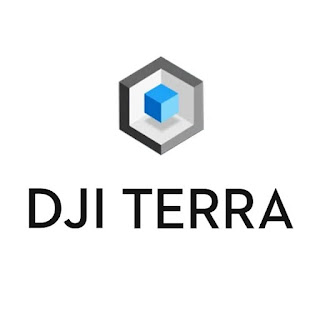 |
| Figure 2: Link to DJI Terra |
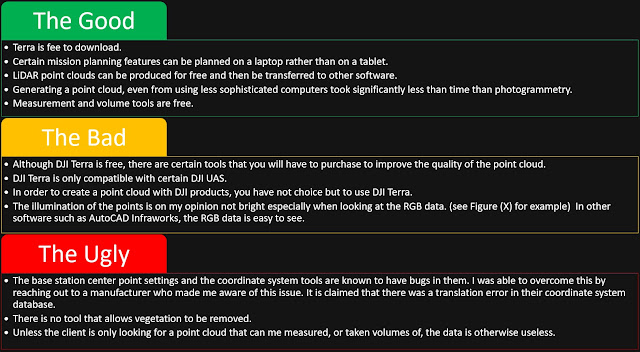 |
| Figure 3: DJI Terra- The Good, The Bad, and The Ugly |
Visualization and Entry Level Tools
As seen in Figure 4, DJI Terra displays points by RGB values, Height, Return, and Reflectivity. Once populated, the user can zoom into features of interest. One of my first concerns while viewing the RGB settings was the occasional dark spots along a tree line (Figure 5).
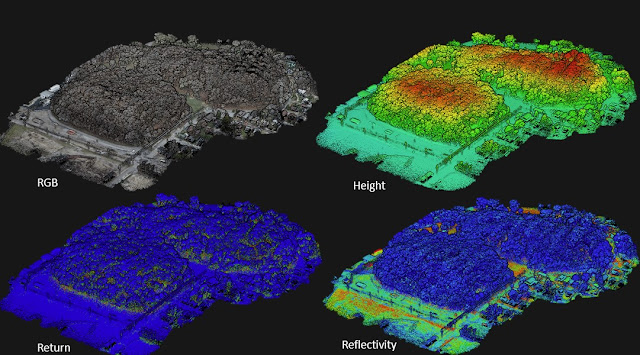 |
| Figure 4: Point Displays in DJI Terra |
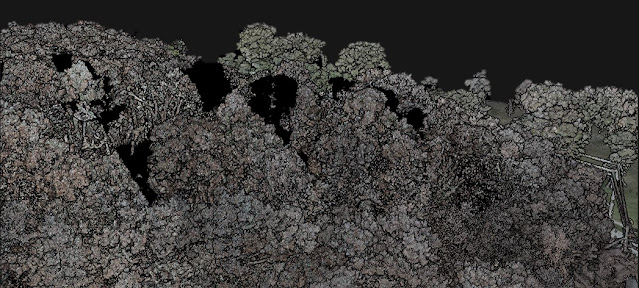 |
| Figure 5: Spots where Photogrammetry Colorization was Missed |
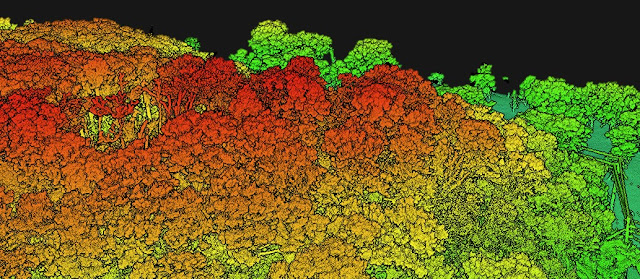 |
| Figure 6: Points Classified by Elevation Have no Dark Spots |
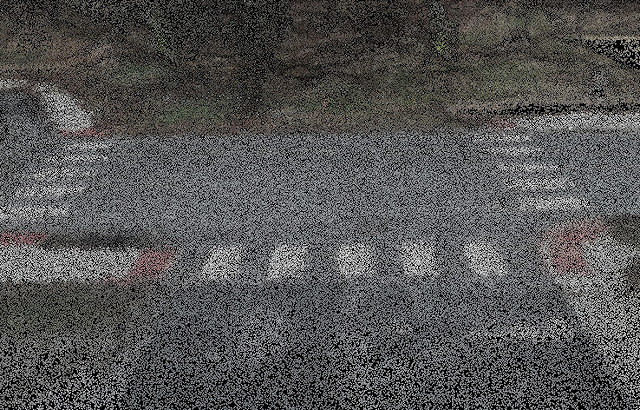 |
| Figure 7: Looking at Pavement Markings |
How DJI Terra Compares to Other Software
Pun not intended; Cloud Compare is a free open-sourced point cloud processing software which can help analyze data from the L1 significantly more than DJI Terra., Below are functions I have been able to achieve using cloud compare:
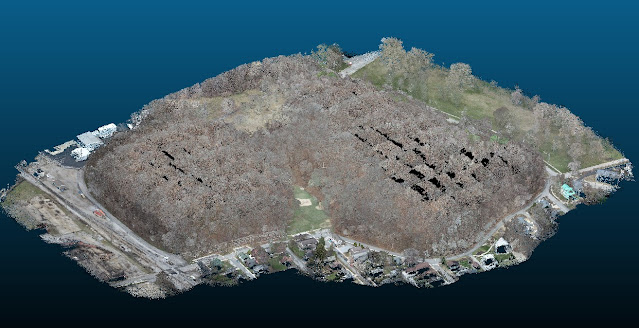 |
| Figure 8: L1 Data Using Cloud Compare |
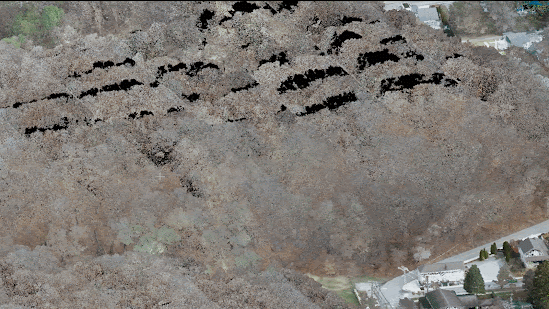 |
| Figure 10: Looking at Vegetation Removal |
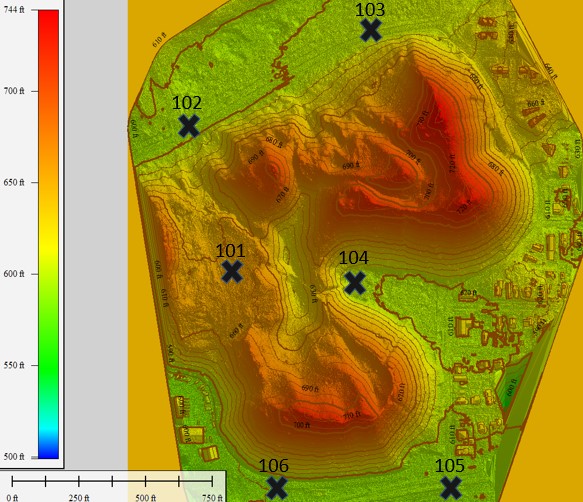 |
| Figure 11: Example Surface Before CAD Integration |
Conclusion
Entry-level LiDAR systems, such as the L1 sensor, can provide value to projects that require a moderate level of absolute accuracy, typically within 1-2 inches. However, claims of centimeter-level accuracy must be scrutinized to determine whether they refer to relative or absolute accuracy. It is worth noting that the L1 sensor may not be suitable for projects that demand detailed feature extraction due to its suboptimal point cloud colorization. While it is possible to improve the colorization by integrating the L1 point cloud with an orthomosaic created by a higher-quality camera, such as the P1, this approach may necessitate additional fieldwork, which comes with its limitations.
Several key takeaways emerged from a project that employed an L1 sensor in a fairly dense forest:
- The LiDAR system was capable of covering areas beneath the vegetation, which is significant.
- A 30-minute flight time could cover approximately 60 acres, which is impressive.
- Generating a LiDAR point cloud was surprisingly fast.
- Vehicle movement caused significant noise in the point cloud, which is something to consider when planning a LiDAR project.
- To get the most out of LiDAR hardware, software beyond DJI Terra will be necessary.
- When viewing profiles from the hard surface, L1 point clouds will exhibit a "fuzz" due to the limitations of the hardware.
- Photogrammetry with survey-grade ground control points (GCPs) appears to work better on hard surfaces than LiDAR.
- If survey-grade LiDAR deliverables are required, the investment may be around $500,000.
Overall, the L1 sensor is a suitable entry-level LiDAR system for projects that require moderate absolute accuracy and involve non-detailed feature extraction. However, it is essential to keep in mind the limitations and challenges that come with using this system, such as the fuzziness of point clouds and the impact of vehicle movement. Proper planning and investment in high-quality hardware, software, and GCPs are critical to ensuring successful LiDAR projects that meet specific requirements.
Saturday, February 25, 2023
Working with Our First Autel UAS
 |
| Figure 1: Autel Evo 2 Pro V2 |
After retiring the DJI Phantom 4 Pro, from our fleet here at USI Consultants, we decided to purchase a non DJI platform to learn about the pros and cons of a UAS that has similar but different functions, capabilities and quirks. Since we were unsure whether an Autel product would be a comparable replacement, we did not want to spend any more money than what we paid for the Phantom 4. As a result, we purchased the Autel Evo 2 Pro V2 depicted in Figure 1.
What is Autel Robotics?
Autel Robotics is a UAS company founded in 2014 that is one of the more prominent rivals to DJI (Da-Jing Innovations). This company produces a vast number rotorcraft consumer and enterprise UAS. Although several of their UAS products are assembled in America, their software Chinese based and their headquarters are in Shenzhen China. See Figure 2 for a brekdown of similarities and differences between Autal and DJI.
 |
| Figure 2: Similaraties and Differences Between Autel and DJI |
References from Venn Diagram:
 |
| Figure 4: Autel World Headquarters |
 |
| Figure 5: DJI world Headquarters |
 |
| Figure 6: Autel foldable UAS Compared to DJI foldable UAS (Image yaken from TecRadar) |
 |
| Figure 7: Autel Ceo Hongjing Li |
 |
| Figure 8: DJI Ceo Frank Wang |
User Experience with the Evo 2 Pro V2 UAS
I paid approximately $1,800 for everything shown in Figure 9, and I found that the accessories are generally reliable considering the price point. However, my biggest disappointment so far is with the remote controller. In my opinion, the latency between the controller screen and the aircraft is terrible. I'm currently researching this issue because I hope it's not a common problem. I'd like to believe that Autel doesn't intentionally sell remote controllers with such poor latency to their customers.
 |
| Figure 9: Autel EVO 2 Pro V2 UAS Bundle |
The Autel Evo 2 Pro drone offers a fair battery life, phone connectivity, and camera quality, along with a remote controller. It also boasts smart features, mapping capabilities, and flight log tracking, similar to a DJI aircraft. However, its radar map is great but limited in scale compared to DJI.
Despite this, the drone's foldability and mapping capabilities make it a great choice for creating Orthomosaic deliverables for engineering designs. Regarding smart features, some work well while others are overhyped and impractical. Nonetheless, the Autel Evo 2 Pro's aircraft, camera, failsafes, and smart features provide excellent value for its price.
Preliminary Conclusions
Overall, the Autel Pro V2 kit offers a reasonable price point and its aircraft and camera configuration deliver reliable performance. Personally, I have found the Autel Evo 2 Pro to be a solid choice, despite my initial mistake in purchasing the remote controller. Nonetheless, I remain open-minded and intend to thoroughly investigate whether a software update or tutorial exists to address the latency issue.
Wednesday, February 1, 2023
My Old Friend the DJI M210
 |
| Figure 1: DJI M210 RTK V2 Aircraft Cameras and Transmitter |
Overview
As of this post, I have logged several hundred hours operating the M210 RTK V2 UAS alone (see Figure 1). Despite some of the drawbacks associated with this platform, I still heavily rely on it for the majority projects I am assigned. Therefore, the purpose of this post is to provide you following:
- A Brief History of Da-Jing Innovations (DJI)
- Questions and Considerations
- Personal experiences using the M210 RTK V2
- Pros and Cons of the M210 RTK V2 UAS
- Looking Ahead at Future UAS
A Brief History of Da-Jing Innovations (DJI)
First, the DJI M210 UAS that I am referencing is the DJI M210 RTK V2. This is emphasized because there is a M200 and an M210 RTK model as well. Don’t quote me on this, but I think the technical name for the Matrice 210 RTK released before the M210 RTK V2 is called the M210 RTK V1. However every comparison Figure I see does not support my claim. Referencing Figure 2 are the Matrice 200 series models. It is my understanding that the M200 were released in 2018 and the M210 RTK versions were released in 2019. This makes the M200 series as a whole pretty old to the point that they are no longer being made available in some countries. Do not be suprised to see them discontinued all together soon.
 |
| Figure 2: DJI Matrice 200 Series |
Like most technology we purchase overseas, it is extremely important to understand how the products are manufactured and how privacy and data security are consented. DJI has had a tumultuous reputation with the United States government since it’s entering the consumer UAS market. I am not exactly sure what caused the U.S. to be concerned about the early DJI aircraft, but I am sure that a DJI crash landing near the whitehouse was a significant factor that lead to lawmakers to question China’s involvement with DJI. After 2018, questions about data security lead to investigations by the Department of Defense (DOD) to better understand how DJI’s aircraft interpret data we collect.
To this day, the DOD has only analyzed two DJI UAS - the Mavic Pro 2 and the M600. Why those two aircraft? I have no idea. Maybe there was the most speculation of malicious activity for those two models at the time? Consider reading the “unauthorized report below” Why is it unauthorized? To answer that, consider readig the next two contradictory paragraphs taken from the verge which is linked below.
After months of government bans on DJI drones, with lawmakers questioning whether the company was sending information to the Chinese government, the Pentagon has admitted that the drones being used might actually be safe (via The Hill), with a report saying that two “Government Edition” DJI drones are “recommended for use by government entities.”
However, on July 23rd, the Department of Defense (DOD) released a statement on the report, saying that its release was “unauthorized,” and reiterating its position that DJI’s drones “pose potential threats to national security.” (via Reuters) It says that its policy around the drones is unchanged, and that there is an investigation into how the “inaccurate and uncoordinated” report was released.
Questions and Considerations
To summarize the controversy behind DJI, the U.S government believes that DJI is using their UAS products to send information back to China. Is this a big deal to you? To me, as a DJI user, I am very disturbed knowing this, but I believe that the M210 RTK V2’s local area data encryption is a way limit potential data sharing. However, I am not stupid, and I understand that it is more than possible that data can be accessed by China other ways.
Then I ask myself, are the projects that I work on involve U.S. government’s critical infrastructure? The answer to that is no. Then I also wonder, if the U.S. is concerned about DJI, then why hasn’t the Pentagon been able to inspect any other DJI aircraft? Furthermore, I was unable to find an explanation of how exactly DJI transmits data to China, so how does that work? Lastly, what else does China have access to but we seem to forget or ignore? Hint: it’s likely in your pocket and you text on it daily!
Personal Experiences Operating the M210 RTK V2
While acknowledging the moral dilemma with cybersecurity and government interest, I continuously communicate with colleagues, management, and clients to ensure they understand the pros and cons of the M210’s capabilities. As a user of the aircraft, understand that (as mentioned earlier) that I am very concerned about data security. In my experience so far, I cannot recall any moments that lead me to think that the information that I collect has been shared, but I could also not know in the first place. In terms of user experiences with this UAS, I have applied it to the following services.
- Erosion Control
- Environmental Documentation
- Tower Inspections
- Thermal Scans
- Roof Inspections
- Fracture Critical Bridge Inspections
- Routine Bridge Inspections
- Timber Bridge Inspections
- 3D Point Cloud Generation
- Georeferenced Orthomosaic Mapping
- Assisted Survey Applications
- Search and Rescue
- Generic Full Motion Videos
- Volumetric Calculations
- Draining Studies
- Marketing Content
- Utility Location
My experiences performing the listed applications very due to the unique parameters of each project, but overall, I have had a 95% success rate. Could this rate have been better using a different aircraft absolutely, but good mission planning and understanding of the could have also helped improve the odds. One area that I struggle with is linear coordor mapping with this aircraft. In past projects I have been very successful, but in one project, I failed because I believe the camera was not effective captureing the particular control point targets. The aircraft’s flight times limits the scope of our project and ultimately our internal cost because the less time we are in the air, the more time we have to spend charging batteries and ultimately the customer. However, lack of flight time is pretty common for rotor craft such as the M210 RTK V2.
Unfortunately at the time, the M210n RTK was in such a niche, there was no affordable aircraft like it (at the time) period. In my opinion, the M210 RTK V2 is excellent for inspecting structures such as bridges due to the fact that it is a rotorcraft and it’s payload configuration. When flying it underneath bridges, it doesn’t feel great, and will still loose signal even with the RTK connected, but the drift is manageable when anticipated! This shouldn’t need to be stated, but the ADSB In aka Airsense is not perfect, especially in areas with hospitals nearby. In fact, most medicvac operations operate in a private frequency (but that is a topic for a different discussion).
Pros and Cons of the M210 RTK V2 UAS
The following pros and cons apply to my experiences using the M210 RTK UAS as a whole. To clarify I have experience using the aircraft, its transmitter and tablet configuration, the Zenmuse X7, XT2 and Z30 payload. Unfortunately I will not go into too much detail regarding the payload due to the fact that each sensor’s performance is greatly dependent on the mission parameters.
Pros
- The aircraft’s failsafes and automatic return to home funchtions help me get me the most battery life while ensuring safety
- The X7 is sharp despite being considered an older camera. It’s quality is cinematic and is extremely useful for mapping
- The XT2 35 mm camera provides fairly impressive thermal imagery and daya. The visual comparison camera is extremely useful for side by side analysis.
- The Z30 has been extremely effective in keeping the aircraft and the target at a safe distance while capturing the amount detail we require
- The aircraft’s FOV camera is extremely beneficial in adding an additional layer of situational awareness
- The autopilot is easy to use and works 99% of the time (occasionally there will be issues with electromagnetic interference
- The RTK has pretty reliable failsafe’s and will ever tell you it it has shifted which is great because its better to catch the shift and correct it rather than get back to the office and find out the hard way
- ADSB In will populate an aircraft icon on the map if it is within a close proximity of the UAS operations. This adds another level of safety for our mission
- The crystal sky monitor is likely one of the better more clear tablets available. It’s quality isn’t perfect, but its better than a phone/tablet.
- The aircraft has flown well in winds above 10mph and in light rain/snow
Cons
- I wish the M210 had a longer battery life. I think everyone wishes that, but charging time is expensive.
- The battery quality is not great and in my opinion is over priced. There is some documentation about battery care, but it is honestly confusing and fairly unrealistic for some
- The standard charger is flimsy and not ideal for field operations. The battery charging case is much better quality but more expensive
- The M210 RTK V2 is no longer being produced by DJI, so those that need that model need to go through third parties.
- The standard carrying case for the M210 RTK is ok but the top section hangs open which overtime will deteriorate
- The tripod for the RTK transceiver is awful, but luckily the Antenna head is compatible with better tripods
- Its not easy transferring data from the tablet to the computer
- It is not easy connecting and understanding the RTK files to the computer
 |
| Figure 3: Autel Evo 2 Pro V2 UAS |
 |
| Figure 5 Freefly Alta UAS |
Tuesday, January 24, 2023
Appreciation Post: I-69 UAS Video
I find great interest in watching unmanned aerial systems (UAS) videos as they offer an opportunity to observe flying maneuvers, media effects, and transitions. The video linked above features a majority of imagery captured with UAS and skillfully integrated with animations and still shots. Although I was not involved in its creation, I believe it to be an excellent example of how UAS can be used to enhance the awareness of large infrastructure projects.
Overall, the UAS content in the video effectively highlights the assets and progress of the project. As someone who has worked on marketing projects on a smaller scale, I can appreciate the amount of effort required to edit the footage into a cohesive less-than-five-minute video. Video editing is an equally important skill, and the use of icons, map animations, and effects in Adobe Premiere Pro are details that bring the series of small videos together, completing the still videos and drone content.
Thursday, January 5, 2023
INDOT and Purdue UAS Report
Aknowledgements
It may sound cliché, but my appreciation for research publications didn't truly blossom until I was part of a team that created one. The credit goes to the two authors, Sarah and Brian Hubbard, who are not only extremely knowledgeable in their field but also approachable and inspiring individuals. Their expertise in the industry proved invaluable, and they managed to make the research process an enjoyable and rewarding experience. Working with them was undoubtedly one of the highlights of my early aviation career, thanks to their positive and honest attitude, coupled with their direct and realistic feedback.
Overview
When I started research, I was a teenager in college at Purdue University, Part 107 was not law, and it was uncertain whether Purdue would offer UAS as a major! Despite this, I was absolutely obsessed with learning about aviation law, UAS technology, and photogrammetry. After taking a few aviation related classes, I met Sarah Hubbard and earned the privilege of doing research for her and Brian Hubbard while balancing a college job to pay the bills, a time-consuming leadership role as a resident assistant, and a video production job creating UAS training content for a private startup. (more about that in a different post.)
What was my role in this Report?
My role in the report was to learn about how UAS was being applied to Department of Transportations (DOTS) because back then, government entities were using Certificate of Authorizations (COAs) to experiment and operate Unmanned Aerial Vehicles (UAVs) legally. For four years, I tracked the applications of UAS in state DOTs and developed criteria to prioritize use cases most beneficial to INDOT’s needs. Throughout the information collection stages of the report, I experienced the before and after affects of Part 107, was introduced to some of DJI’s earliest aircraft (which probably do not fly today) and provided consultation and recommendations to INDOT before they had a UAS program. (this wasn’t that long ago but I feel old!)
Is the Content in the Report Old?
As much as I do not want to admit, one can argue that I lived through some historical moments that still affect us today. Looking back at this report in 2023, although the referenced aircraft are old, many of the specific applications have been implemented and are part of INDOT's UAS program. If you are interested in learning about what UAS applications we recommended for INDOT, open the report below.
Monday, January 2, 2023
How Enterprise UAS Offer Value to Civil Engineering Projects
Friday, December 23, 2022
Happy Holidays From USI
See Alan Cry and Then Have to Get Back to Work
Oh boy, looks like the marketing team decided to spice things up for the holidays! Instead of the usual holiday stuff, they came up with a brilliant idea: have our brave colleagues taste some fiery hot sauce and film their hilarious reactions!I was one of the unfortunate souls who took on this hot challenge. Let me tell you, I felt like i was conbusting in the inside! I mean, I can barely handle a flaming hot Cheeto, let alone a sauce with the following stats:
Wednesday, November 16, 2022
Can UAS Themal Data Add Value to Bridge Inspections?
Overview
Many know that thermal equipped UAS are useful for infrastructure inspections, but few know how they add value compared to traditional inspection methods. In the case of concrete deck inspections, thermal equipped UAS can be an extremely valuable tool because the collected data can expose deficiencies often invisible to the naked eye. I am not going to spell out how exactly this translates into cost savings, but the value can be in the tens of millions depending on the structure scanned.
Secret Hints About UAS Thermal Ops
From a deliverable standpoint, the product is a preventative maintenance plan. To get to that point, be prepared for a big investment in a specific thermal camera, take more than one thermography training and have design and structural engineers in your office. If you get that far, make sure your thermal imagery has visual reference imagery, invest heavily in computer software, and make sure you have the aircraft and camera settings dialed in.
Oh yeah, make sure you can legally the area of interest in the first place! At this point, I have provided more than enough hints about how thermal offers value to concrete bridge deck inspections including the document below that I created with USI Consultants. If you have any questions, please reach out to me directly.
